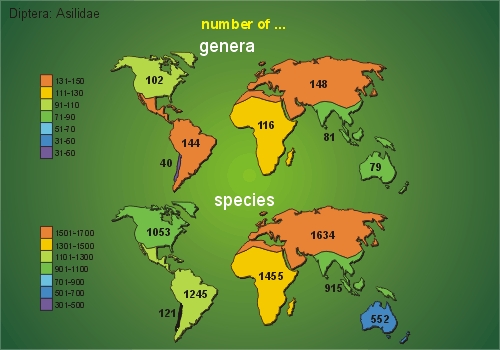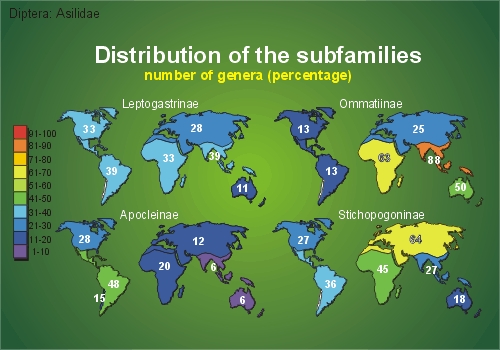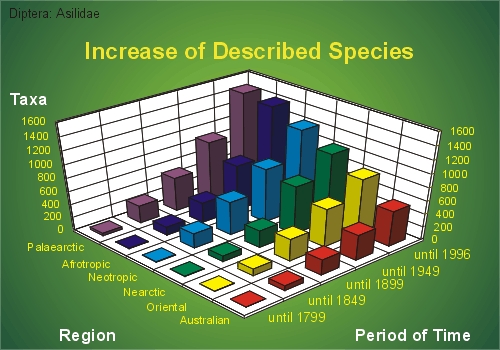General notes
Distribution
Collecting
Research
Photography
Literature
Internet
Acknowledgement
Imprint
The family Asilidae is one of the most diverse in the order Diptera. 6,892 valid species and 522 genera are described (GELLER-GRIMM, 2005). The oldest proof is from the Upper Jurassic (187 bis 208 Mio.).

Robber flies inhabit all regions of the world except the arctic regions. The highest diversity is in the subtropical and tropical regions, but our knowledge of these fauna is insufficient and the number of new described species increases rapidly. It seems to be that robber flies prefer open areas. In some deserts they are amongst the dominant predators.
Our impression of the distribution is dependent on the knowledge of species. A first assumption is possible on the subfamily level. For example: The Leptogastrinae are distributed world-wide, whereas the Ommatiinae are concentrated in the Oriental, Afrotropical and Australian regions - the Stichopogoninae in the Palaearctic region - and the Apocleinae in the Neotropics.

The knowledge of the distribution depends on the number of workers. The highest rate of new described taxa is found in Southern Africa, Eastern Russia and Chile during the last 30 years. The results make it clear that the research on Asilidae has just started. Therefore we need more enthusiasts for this interesting family.

There have been several checklists of Asilidae published for different North American States in the last years. Not all of them are a solid base for faunistic studies, because of the lack of thorough identification of the material on which the lists are based. Some of them are only summaries of species cited in very old literature.
The diversity is quite higher in the South-West of North America. North of the USA, the number of species is reduced by different cold phases of the Pleistocene and the climate.
The knowledge of the US fauna is high in comparison with that of Mexico and Canada. Several taxa are still uncertain and the presence of undescribed species is probable.
Number of species per state
105 genera with 1075 valid species are known from the Nearctic region. The following image shows the number of species per state except for Mexico, because only a little is known about the distribution. Remarkable is the high diversity in California in comparison with that of the neighbouring states. Furthermore there is a lack of information for some southern states of the USA, like Louisana, Mississippi, Alabama, and Arkansas.

- Number of species per state -
Canada: 199 species
- ALB (Alberta): 88 species - BCA (British Columbia): 115 species - LAB (Labrador): 1 species - MAN (Manitoba): 26 species - NBK (New Brunswick): 5 species - NEW (Newfoundland): 1 species - NSA (Nova Scotia): 14 species - NWT (North West Territory): 9 species - ONT (Ontario): 42 species - PEI (Prince Edward Island): no species recorded - QUE (Quebec): 38 species - SKW (Saskatchewan): 21 species - YUK (Yukon Territory): 21 species
- AK (Alaska): 7 species - AL (Alabama): 68 species - AR (Arkansas): 64 species - AZ (Arizona): 281 species - CA (California): 419 species - CO (colorado): 156 species - CT (Connecticut): 42 species - DC (District of Columbia): 29 species - DE (Delaware): 19 species - FL (Florida): 116 species - GA (Georgia): 121 species - IA (Iowa): 43 species - ID (Idaho): 91 species - IL (Illinois): 70 species - IN (Indiana): 70 species - KS (Kansas): 137 species - KY (Kentucky): 85 species - LA (Louisana): 42 species - MA (Massachusetts): 54 species - MD (Maryland): 70 species - ME (Maine): 37 species - MI (Michigan): 89 species - MN (Minnesota): 32 species - MO (Missouri): 57 species - MS (Mississippi): 70 species - MT (Montana): 76 species - NC (North Carolina): 113 species - ND (North Dakota): 30 species - NE (Nebraska): 57 species - NH (New Hampshire): 42 species - NJ (New Jersey): 45 species - NM (New Mexico): 215 species - NV (Nevada): 135 species - NY (New York): 86 species - OH (Ohio): 100 species - OK (Oklahoma): 119 species - OR (Oregon): 159 species - PA (Pennsylvania): 108 species - RI (Rhode Island): 8 species - SC (South Carolina): 89 species - SD (South Dakota): 69 species - TN (Tennessee): 83 species - TX (Texas): 239 species - UT (Utah): 178 species - VA (Virginia): 100 species - VT (Vermont): 34 species - WA (Washington): 141 species - WI (Wisconsin): 35 species - WV (West Virginia): 61 species - WY (Wyoming): 95 species
- AGU (Aguascalientes): 3 species - BCF (Baja California Norte): 70 species - BCS (Baja California Sur): 22 species - CHA (Chihuahua): 20 species - COA (Coahuila): 11 species - DUR (Durango): 12 species - GUO (Guanajuato): 2 species - HID (Hidalgo): 3 species - JAL (Jalisco): 9 species - MIH (Michoacan): no species recorded - NLE (Nuevo Leon): 12 species - QUO (Queretaro): no species recorded - SLP (San Luis Potosi): 8 species - SON (Sonora): 50 species - TAM (Tamaulipas): 15 species - ZAC (Zacatecas): 9 species
Fossil records from North America
There are 29 species described from fossils, from which 2 are recent.
- Asilopsis fuscula Cockerell, 1920 [USA, Eocene, Green River shales]
- Asilus palaeolestes Cockerell, 1921 [USA, Eocene, Green River shales]
- Asilus peritulus Cockerell, 1909 [USA, Oligocene, Florissant shales, colorado]
- Asilus wickhami Cockerell, 1915 [USA, Oligocene, Florissant shales, colorado]
- Asilus curculionis Melander, 1947 [USA, Oligocene, Florissant shales, colorado]
- Asilus amelanchieris Cockerell, 1911 [USA, Oligocene, Florissant shales, colorado]
- Asilus florissantinus James, 1939 [USA, Oligocene, Florissant shales, colorado]
- Blepharepium borealis (James, 1939) [USA, Oligocene, Florissant shales, colorado - recent]
- Ceraturgus praecursor (James, 1939) [USA, Oligocene, Florissant shales, colorado]
- Cophura antiquella Cockerell, 1913 [USA, Oligocene, Florissant shales, colorado]
- Dioctria pulveris Cockerell, 1917 [USA, Oligocene, Florissant shales, colorado]
- Dioctria florissantina (Cockerell, 1909) [USA, Oligocene, Florissant shales, colorado]
- Dioctria jamesi Lewis, 1972 [USA, Oligocene, Ruby River Basin, Montana]
- Holopogon archilestris Hull, 1960 [USA, Oligocene, Ruby Basin, Montana]
- Leptogaster prior Melander, 1947 [USA, Oligocene, Florissant shales, colorado]
- Lestomyia miocenica James, 1939 [USA, Oligocene, Florissant shales, colorado]
- Microstylum wheeleri Cockerell, 1908 [USA, Oligocene, Florissant shales, colorado]
- Microstylum destructum Cockerell, 1909 [USA, Oligocene, Florissant shales, colorado]
- Nicocles miocenicus Cockerell, 1909 [USA, Oligocene, Florissant shales, colorado]
- Palaeomolobra antiqua (James, 1939) [USA, Oligocene, Florissant shales, colorado]
- Philonicus saxorum James, 1939 [USA, Oligocene, Florissant shales, colorado]
- Saropogon oblitescens Cockerell, 1914 [USA, Oligocene, Florissant shales, colorado]
- Senoprosopis romeri Hull, 1958 [USA, Oligocene, Florissant shales, colorado]
- Senoprosopis beckeri Lewis, 1972 [USA, Oligocene, Ruby River Basin, Montana]
- Senoprosopis eureka Melander, 1949 [USA, Oligocene, Florissant shales, colorado]
- Stenocinclis anomala Scudder, 1878 [USA, Oligocene, Green River shales]
- Taracticus renovatus Cockerell, 1911 [USA, Oligocene, Florissant shales, colorado]
- Taracticus contusus Cockerell, 1910 [USA, Oligocene, Florissant shales, colorado]
- Tipulogaster glabrata (Wiedemann, 1828) [USA, Canada, Oligocene - recent]
Contents: © Fritz Geller-Grimm, Jorge N. Artigas, 2007
Layout & images: © Fritz Geller-Grimm, 2007